If you’ve ever experienced back pain, you know how quickly it can interrupt your day and limit your movement. For many, inversion therapy offers a simple, natural way to find relief by helping the spine decompress and muscles relax. But if you’ve ever wondered whether hanging upside down is safe or actually effective, you’re not alone.
Let’s take a closer look at how inversion therapy works, what the current research shows, and how to use an inversion table safely and comfortably.
What Is Inversion Therapy?
Inversion therapy uses gravity to gently stretch and decompress the spine. Whether you’re using an inversion table, gravity boots, or a device like the Teeter DEX, reclining with your head below your feet can help reduce pressure on your back and ease tension in the muscles and joints.
When you’re upright all day – standing, sitting, or moving around – the force of gravity is constantly compressing your spine. Over time, this can lead to stiffness, nerve pressure, and discomfort. Inversion therapy gives your body a break from that compression, allowing the spine to elongate and relax naturally.
Many people call it a “reset” for their back, similar to taking a deep breath but for your spine. It helps to stretch and relax your back after sitting or standing for a long time.
What the Research Says
Studies on inversion therapy show encouraging results. For example, a 2012 study conducted at Newcastle University found that patients with sciatica who practiced inversion therapy were significantly less likely to require surgery compared to those who did not (read more here).
Benefits of Inversion Therapy

1. Relieves Back Pain and Sciatica
By gently stretching the spine, inversion helps take pressure off the discs and nerves that contribute to lower back pain and sciatica. This release encourages nutrients and fluids back into the discs, which can lead to better spinal health over time. Many people notice less tension and feel more comfortable after just a few sessions, although results can differ from person to person.
2. Improves Flexibility and Mobility
Regular inversion techniques can help relax tight muscles and joints, making it easier to move and bend comfortably. By easing tension in the back and hips, it can improve your posture and increase flexibility, especially if you sit or stand for long periods.
3. Supports Spinal Health
When the spine decompresses, the space between vertebrae slightly increases, giving your discs room to rehydrate. This can help counteract the daily pressure from gravity and support proper spinal alignment over time.
4. Encourages Relaxation
Inversion therapy can also have a calming effect. The gentle traction helps relax muscles and improve blood flow, making it easier to relax and reduce stress. Some people say they experience better sleep after inverting.
How to Use an Inversion Table Safely
Inversion therapy is generally safe for most healthy adults when done correctly. The key is to start slow, listen to your body, and use quality equipment designed for safety and comfort.
Here are some best practices for how to use an inversion table safely:
- Start Gradually: Begin at a gentle angle, around 20 to 30 degrees, for about 1 to 2 minutes. As you feel more comfortable, you can slowly increase the angle and the time. Even a small tilt can help ease discomfort.
- Breathe and Relax: Take slow, steady breaths and try to relax your body into the position instead of tensing up.
- Come Up Slowly: Always return to an upright position in a controlled manner to avoid dizziness or discomfort. Pause just above horizontal to allow yourself to gently recompress before slowly disengaging from the ankle supports.
- Have a Spotter: Especially when you’re just starting out and finding your ideal settings, having someone nearby can help you feel more confident and secure. Once you find the perfect settings for your body type, you will be able to control your rotation with simple arm movements.
- Keep a Routine: Short, regular sessions work better than longer, less frequent sessions. Aim to invert for a few minutes 2-3 times each day as regular maintenance for your spine and weight-bearing joints.
Safety Considerations
Practically anyone can benefit from using a Teeter on a regular basis. Most normally healthy individuals are able to invert. However, as with any exercise or therapy, you should consult your doctor before beginning.
Inversion is contraindicated in any medical or health condition that may be made more severe by an increase in blood pressure, intracranial pressure, or mechanical stress from the inverted position. This may include conditions of the heart, eyes, bones, or spine, or other illnesses or injuries. Always check with a licensed healthcare professional if you have questions or concerns before inverting.
It’s also important to use a reliable inversion table built to verified safety standards, such as FDA-registered and UL-certified models. FDA registration means the device meets established medical device reporting and labeling requirements, while UL certification indicates it has passed independent safety and durability testing.
Alternatives and Additional Options
Inversion tables are just one way to help stretch and relieve pressure on the spine. There are other methods that can work alongside or offer similar benefits, depending on what feels best for you:
- DEX II Inversion & Core Training System: A forward-rotating system that supports from the hips to focus decompression on the lower back and isolate the core for controlled back extension and strength training exercises.
- Gravity Boots: Allow full inversion from a bar or rack for advanced users who want a deeper stretch and the freedom of movement required for advanced inverted exercises.
- Teeter P2 Back Stretcher: This non-inversion traction device offers a method of manual stretching to help decompress the lower back while sitting or lying down.
Each of these options helps to decompress the spine in different ways. The best choice depends on your comfort, mobility, and experience level.
Why Teeter Inversion Tables Stand Out

Teeter FitSpine Inversion Tables are FDA-registered as Class 1 medical devices, indicated for back pain, sciatica, muscle tension, and more. Each model is UL safety-certified and designed for precision balance and controlled rotation, so you can invert confidently. These certifications mean Teeter Inversion Tables have been tested for stability, weight limits, and overall safety, giving you peace of mind.
The comfortable ankle supports, adjustable features, and sturdy frame ensure each session feels secure and comfortable, so you can concentrate on what matters most: relieving back pain safely.
The Bottom Line
Inversion therapy offers a natural, restorative way to care for your back and relieve tension. When used correctly, it helps decompress the spine, reduce muscle tightness, and support overall spinal health. Best of all, it’s a simple habit that you can add to your daily routine in just a few minutes.
For some people, inversion therapy can be a safe and helpful option if done properly and after checking with your healthcare provider. Using a Teeter inversion table can make a big difference, allowing you to experience back pain relief comfortably and safely.
Get Real Back Pain Relief
Join over 3 million people who have found real back pain relief with Teeter.
